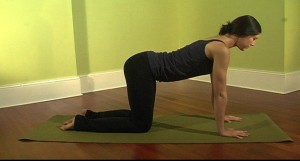

The idea of psoas major release work covers a lot of territory. There are psoas major release exercises that allow gravity to do its thing. These are among my favorite psoas major release exercises like Constructive Rest Position and Foot on a Block. There are more active psoas major release exercises like Block Lunges (another favorite) and then there are experiential psoas major release exercises like the one in the picture above.
The point of this psoas major release, Releasing Hands and Knees, is to see if you can extend one leg back without moving anything but the leg. If one psoas is tight this will be very difficult and it will also be very different on either side. The psoas is not the only reason that you might shift out of your stable center but it will always be involved.
Psoas Major Release: Releasing Hands And Knees
- This exercise explores the ability of the leg to separate from the pelvis and the spine.
- Start on your hands and knees with the hips over the knees and the wrists underneath the shoulders.
- Bring gentle tone to the pelvic floor and the lower belly and try to extend your right leg back, bringing the leg level with the trunk.
- Keep your awareness on the lower back and the pelvis, stabilizing the trunk to release the leg backwards.
- Only the leg wants to move. Try not to shift your weight to one side or the other, or lift one hip higher than the other.
This is an experiential exercise where you are trying to get a feeling for what the body is doing. The tighter psoas will be the side that can’t move without pulling the pelvis and the spine with it.
